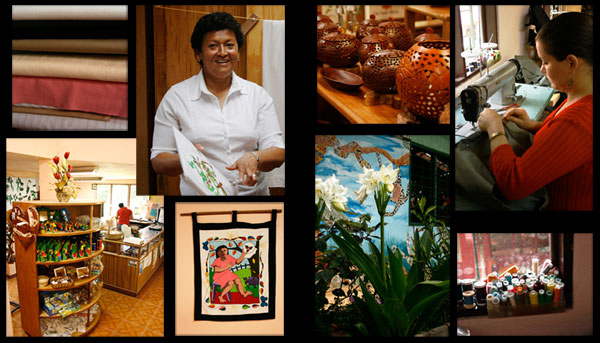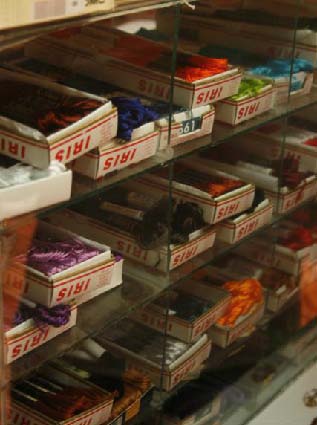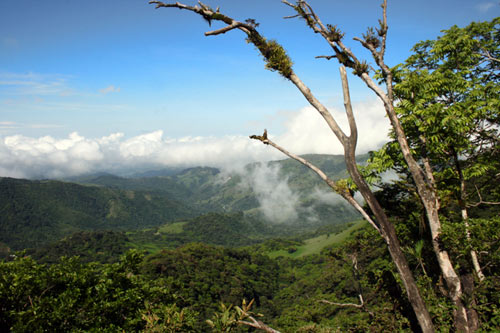CASEM

Written by Lindsay A. Glick and Elizabeth Speigle
Economic and Social Empowerment
Without knowing its history, it could be a gift shop no different from the hundreds of others in Costa Rica. Adorned with the bright flowers, exotic birds, and opulent plants that characterize the tropical nature of the country, the merchandise is meant for tourists hoping to take home a piece of this paradise. However, the women who created CASEM, the Cooperativa de Artesanas de Santa Elena y Monteverde, give it reason to be so much more.
To understand the strength and dedication of the women who formed CASEM, one must understand the Costa Rican culture. As is true in other Latin American countries, Costa Rica is a culture based in a machismo mentality where males dominate the public sphere and women are often relegated to the private, or domestic, sphere. It was out of this reality that, in 1982, eight women brought together their talents in order to form a group that would not only give them economic independence and opportunity, but a support network that would continue to empower them to this day.
 During the 1970s and 1980s, the Monteverde region began to flood with researchers hoping to explore the unblemished Monteverde Cloud Forest. These researchers, along with craving knowledge of the forest, also wanted souvenirs they could take with them when they returned home. Thus, when Patricia Jiménez and a small group of women got together in 1981 to make crafts, they had an immediate market for their work. In 1982, with the help of a loan from the Inter-American Foundation, a group of eight women began CASEM. Jiménez explains that in the beginning there were only eight women, but within a year of their humble beginning there were 30 members, and at its highest point membership has reached 150. Today there are 127 members, engaging a large number of women in the community.
During the 1970s and 1980s, the Monteverde region began to flood with researchers hoping to explore the unblemished Monteverde Cloud Forest. These researchers, along with craving knowledge of the forest, also wanted souvenirs they could take with them when they returned home. Thus, when Patricia Jiménez and a small group of women got together in 1981 to make crafts, they had an immediate market for their work. In 1982, with the help of a loan from the Inter-American Foundation, a group of eight women began CASEM. Jiménez explains that in the beginning there were only eight women, but within a year of their humble beginning there were 30 members, and at its highest point membership has reached 150. Today there are 127 members, engaging a large number of women in the community.
Through the efforts of its members, CASEM has grown into a strong crafts-based cooperative, with merchandise ranging from bags, shirts and jewelry to sculpture and paintings, and while the women who comprise the group are as varied as its merchandise, they often have similar backgrounds that bring them together.
Jiménez believes women initially joined the group because it gave them a chance to simply get together with other women and participate in communal events. They were living isolated lives on farms with significant distance in between, but CASEM gave them an opportunity to gather, share their concerns, and generally just have a good time together. There were often talks about birth control and raising children, something most, if not all, of the women could relate to, and Jiménez even shared her own story of having a hysterectomy after the birth of her second child.
The group became much more than just a source of income for the women, though the economic subsidy was also important. While there was a six-item minimum on the amount of work each woman had to produce a month, it still couldn’t provide a full-time job. It did provide for them an opportunity to pursue a sense of independence and autonomy they had not known in the past, and as many were raising children at the same time, the flexibility allowed them to keep pursuing their independence. Jiménez explains that the decision making in the group was very democratic, something many of the women did not experience in their homes. Leaders naturally emerged from the group, and it was decided that no one person could have more than one million colones.
 While these guidelines created a space in which many women could work, some found that as their creativity and art grew, they felt the need to leave the group to pursue larger venues. Ana Ovares, a former member of CASEM, now works selling her paintings, ceramics, and other creations in Monteverde independently. She explains that the crafts she was doing with CASEM opened the door for her creatively, but she couldn’t sell her work otherwise so she felt obligated to leave. She believes that the limits and guidelines in place with CASEM are good, but that she needed to be able to continue to grow outside those guidelines.
While these guidelines created a space in which many women could work, some found that as their creativity and art grew, they felt the need to leave the group to pursue larger venues. Ana Ovares, a former member of CASEM, now works selling her paintings, ceramics, and other creations in Monteverde independently. She explains that the crafts she was doing with CASEM opened the door for her creatively, but she couldn’t sell her work otherwise so she felt obligated to leave. She believes that the limits and guidelines in place with CASEM are good, but that she needed to be able to continue to grow outside those guidelines.
CASEM has also been a starting place for increasing awareness about women’s issues. Although domestic violence was not openly discussed in the group, Jiménez recounts how during her early years in CASEM and Monteverde, “you could hear people screaming and asking for help in the middle of the night.” Knowing that there were women in the group who were being beaten at home and couldn’t make their own decisions, Jiménez began working to create awareness about these situations, along with the Monteverde Institute à (link) and the local community of Quakers. Jenny Peña, à (link) an invaluable resource in the community who works at the institute, helped develop a network for the women with the police department. Jiménez stresses that having information about the law and its protection is a very important tool for victimized women.
Combined with the equality and justice women have found in the law, CASEM has been a powerful force in changing the lives of women in Monteverde. Jiménez believes the main achievement of the group has been its empowerment of the women involved. The women recognize that they don’t have to rely on other people to survive; they are not only capable of being self-sufficient, but they have proven their creativity with only a small amount of materials. Jiménez knows that the women of Costa Rica are strong and honest, and hopes that CASEM has planted a seed for future craft people within the community.